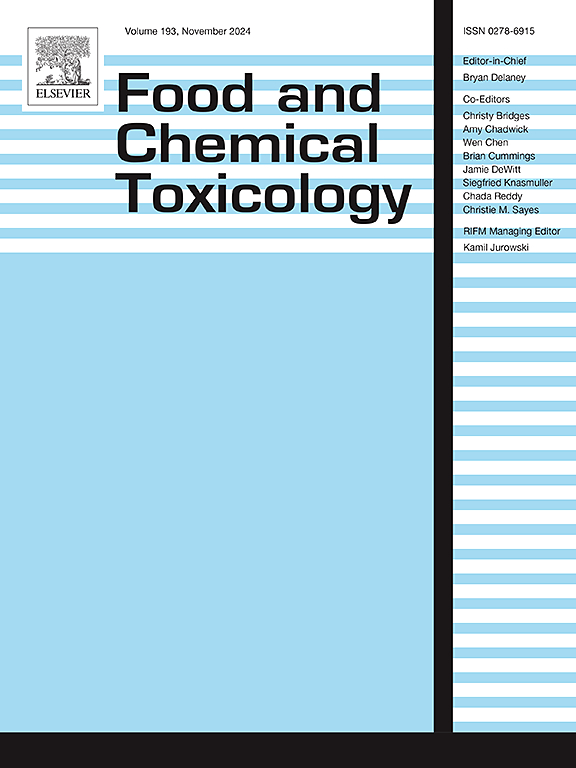Identification of the metabolomic alterations associated with the formation of bisphenol-A sulfate metabolite in HepG2 cells
IF 3.9
3区 医学
Q2 FOOD SCIENCE & TECHNOLOGY
引用次数: 0
Abstract
The elucidation of the causal relationship between bisphenol-A (BPA) exposure and hepatoxic outcomes is challenging because of the complexity in both the BPA-derived metabolites formed in the liver and the associated endogenous molecular responses. We performed parallel metabolism experiments with BPA to characterize the BPA sulfate formation and the associated alterations in the metabolome level in HepG2 cells using mass spectrometry-based metabolome wide association study. Briefly, HepG2 cells were exposed for 8 or 24 h to 1 or 10 μM BPA in DMSO or DMSO alone. The levels of BPA sulfate in the cell culture media were quantified, and the sulfation efficiency was about 0.4 % observed for both 1 and 10 μM BPA in HepG2 cells. Targeted metabolomic analyses revealed alterations belonging to forty metabolic pathways following BPA exposure. Featured by the decreasing of estrone sulfate, estrogen metabolism was observed as the top 1 enriched pathway in response to BPA exposure. MWAS suggests that BPA sulfate formation in HepG2 cells resulted in vitamin B6 deficiency and dysregulated vitamin B6-dependent processes, for example, the kynurenine pathway in tryptophan metabolism. These findings collectively provide insights into the linkage between exogenous and endogenous metabolism and the potential initial events in BPA exposure-relevant hepatoxicity.

HepG2细胞中与双酚a硫酸盐代谢物形成相关的代谢组学改变的鉴定。
由于肝脏中形成的双酚a衍生代谢物和相关内源性分子反应的复杂性,阐明双酚a (BPA)暴露与肝氧化结果之间的因果关系具有挑战性。我们使用基于质谱的代谢组广泛关联研究,对BPA进行平行代谢实验,以表征HepG2细胞中BPA硫酸盐的形成和代谢组水平的相关变化。简单地说,HepG2细胞暴露于1 μM或10 μM双酚a的DMSO或单独DMSO中8或24 h。测定了细胞培养液中硫酸双酚a的含量,发现1 μM和10 μM双酚a对HepG2细胞的硫酸效率均为0.4%左右。有针对性的代谢组学分析揭示了BPA暴露后40种代谢途径的改变。以硫酸雌酮水平降低为特征,雌激素代谢是BPA暴露的前1富集途径。MWAS表明,在HepG2细胞中形成硫酸双酚a导致维生素B6缺乏和维生素B6依赖过程失调,例如色氨酸代谢中的犬尿氨酸途径。这些发现共同提供了外源性和内源性代谢与BPA暴露相关肝毒性潜在初始事件之间联系的见解。
本文章由计算机程序翻译,如有差异,请以英文原文为准。
求助全文
约1分钟内获得全文
求助全文
来源期刊

Food and Chemical Toxicology
工程技术-毒理学
CiteScore
10.90
自引率
4.70%
发文量
651
审稿时长
31 days
期刊介绍:
Food and Chemical Toxicology (FCT), an internationally renowned journal, that publishes original research articles and reviews on toxic effects, in animals and humans, of natural or synthetic chemicals occurring in the human environment with particular emphasis on food, drugs, and chemicals, including agricultural and industrial safety, and consumer product safety. Areas such as safety evaluation of novel foods and ingredients, biotechnologically-derived products, and nanomaterials are included in the scope of the journal. FCT also encourages submission of papers on inter-relationships between nutrition and toxicology and on in vitro techniques, particularly those fostering the 3 Rs.
The principal aim of the journal is to publish high impact, scholarly work and to serve as a multidisciplinary forum for research in toxicology. Papers submitted will be judged on the basis of scientific originality and contribution to the field, quality and subject matter. Studies should address at least one of the following:
-Adverse physiological/biochemical, or pathological changes induced by specific defined substances
-New techniques for assessing potential toxicity, including molecular biology
-Mechanisms underlying toxic phenomena
-Toxicological examinations of specific chemicals or consumer products, both those showing adverse effects and those demonstrating safety, that meet current standards of scientific acceptability.
Authors must clearly and briefly identify what novel toxic effect (s) or toxic mechanism (s) of the chemical are being reported and what their significance is in the abstract. Furthermore, sufficient doses should be included in order to provide information on NOAEL/LOAEL values.
 求助内容:
求助内容: 应助结果提醒方式:
应助结果提醒方式:


